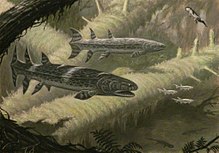Hyneria
| Hyneria Temporal range:
| |
|---|---|

| |
| Restoration | |
| Scientific classification | |
| Kingdom: | Animalia |
| Phylum: | Chordata |
| Clade: | Eotetrapodiformes |
| Family: | †Tristichopteridae |
| Genus: | †Hyneria , 1968 |
| Type species | |
| †Hyneria lindae Thomson, 1968
| |
Hyneria is a genus of large prehistoric predatory lobe-finned fish which lived in freshwater during the Devonian period around 360 million years ago.[2]
Etymology[]
The genus name Hyneria is a reference to the village of Hyner, Pennsylvania, near where the first specimen was found. The species epiphet H. lindae is derived from the name of the wife of Keith Stewart Thomson, who described this fish.[3]
Description[]
Hyneria was a large fish, estimated at 2.5–3.7 m (8.2–12.1 ft) in total length.[3][4] Its skull had heavy, ornamented dermal bones and its lower jaw was relatively long and shallow. The teeth were stout with those of the premaxilla forming fangs upwards of 5 cm (2 in).[3][5] Its body was covered by cycloid scales.[5][4] It had large sensory canals to aid in detection of possible prey, as the freshwater environment it inhabited likely was murky and had low visibility.[4]
Discovery[]
The original fossils came from two localities in Pennsylvania, United States, one found between the villages of North Bend and Hyner and another near Emporium. They consisted of a disarticulated partial skull and fragments of the shoulder girdle.[3] The fossils were found in the Catskill Formation of the Red Hill Shale, dating to the upper Devonian.[5] These were the only remains known until 1993 when a renewed collecting effort discovered abundant new material.[5] Hyneria is considered the largest and most common lobe-finned fish found in the Red Hill Shale.[6]
References[]
- ^ Haines, Tim; Chambers, Paul (2006). The Complete Guide to Prehistoric Life (illustrated ed.). Canada: Firefly Books. pp. 32–33. ISBN 978-1-55407-181-4.
- ^ Illustrating a Devonian Predator | CoAS | Drexel University
- ^ a b c d Thomson, K. S. (1968). "A new Devonian fish (Crossopterygii: Rhipidistia) considered in relation to the origin of the Amphibia". Postilla. 124.
- ^ a b c "25 years of fossil collecting yields clearest picture of extinct 12-foot aquatic predator". ScienceDaily. 7 May 2018.
- ^ a b c d Daeschler, EB; Shubin, NH (2007). "New data on Hyneria lindae (Sarcopterygii, Tristichopteridae) from the Late Devonian of Pennsylvania, USA". Journal of Vertebrate Paleontology. 27 (S3). doi:10.1080/02724634.2007.10010458.
- ^ "The Missing Link". Nova. Season 29. Boston. February 26, 2002. PBS. Transcript: "The Missing Link".
External links[]
- Hyneria at Devonian Times
- Tristichopterids
- Prehistoric lobe-finned fish genera
- Devonian fish of North America
- Late Devonian animals
- Fossil taxa described in 1968
- Prehistoric lobe-finned fish stubs






